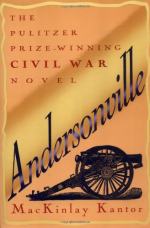Occasionally we came to great piles of barrels of turpentine, rosin and tar, some of which had laid there since the blockade had cut off communication with the outer world. Many of the barrels of rosin had burst, and their contents melted in the heat of the sun, had run over the ground like streams of lava, covering it to a depth of many inches. At the enormous price rosin, tar and turpentine were commanding in the markets of the world, each of these piles represented a superb fortune. Any one of them, if lying upon the docks of New York, would have yielded enough to make every one of us upon the train comfortable for life. But a few months after the blockade was raised, and they sank to one-thirtieth of their present value.
These terebinthine stores were the property of the plantation lords of the lowlands of North Carolina, who correspond to the pinchbeck barons of the rice districts of South Carolina. As there, the whites and negros we saw were of the lowest, most squalid type of humanity. The people of the middle and upland districts of North Carolina are a much superior race to the same class in South Carolina. They are mostly of Scotch-Irish descent, with a strong infusion of English-Quaker blood, and resemble much the best of the Virginians. They make an effort to diffuse education, and have many of the virtues of a simple, non-progressive, tolerably industrious middle class. It was here that the strong Union sentiment of North Carolina numbered most of its adherents. The people of the lowlands were as different as if belonging to another race. The enormous mass of ignorance—the three hundred and fifty thousand men and women who could not read or write—were mostly black and white serfs of the great landholders, whose plantations lie within one hundred miles of the Atlantic coast.
As we approached the coast the country became swampier, and our old acquaintances, the cypress, with their malformed “knees,” became more and more numerous.
About the middle of the afternoon our train suddenly stopped. Looking out to ascertain the cause, we were electrified to see a Rebel line of battle stretched across the track, about a half mile ahead of the engine, and with its rear toward us. It was as real a line as was ever seen on any field. The double ranks of “Butternuts,” with arms gleaming in the afternoon sun, stretched away out through the open pine woods, farther than we could see. Close behind the motionless line stood the company officers, leaning on their drawn swords. Behind these still, were the regimental officers on their horses. On a slight rise of the ground, a group of horsemen, to whom other horsemen momentarily dashed up to or sped away from, showed the station of the General in command. On another knoll, at a little distance, were several-field pieces, standing “in battery,” the cannoneers at the guns, the postillions dismounted and holding their horses by the bits, the caisson men standing in readiness to serve out ammunition. Our men were evidently close at hand in strong force, and the engagement was likely to open at any instant.




